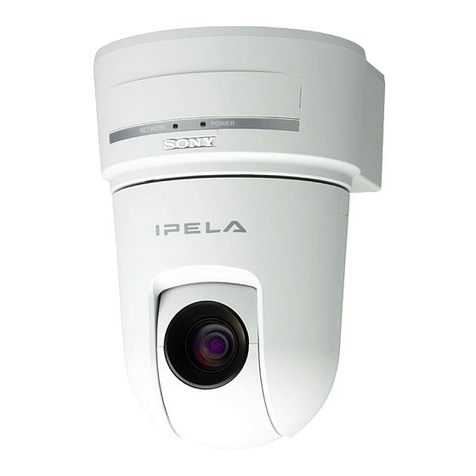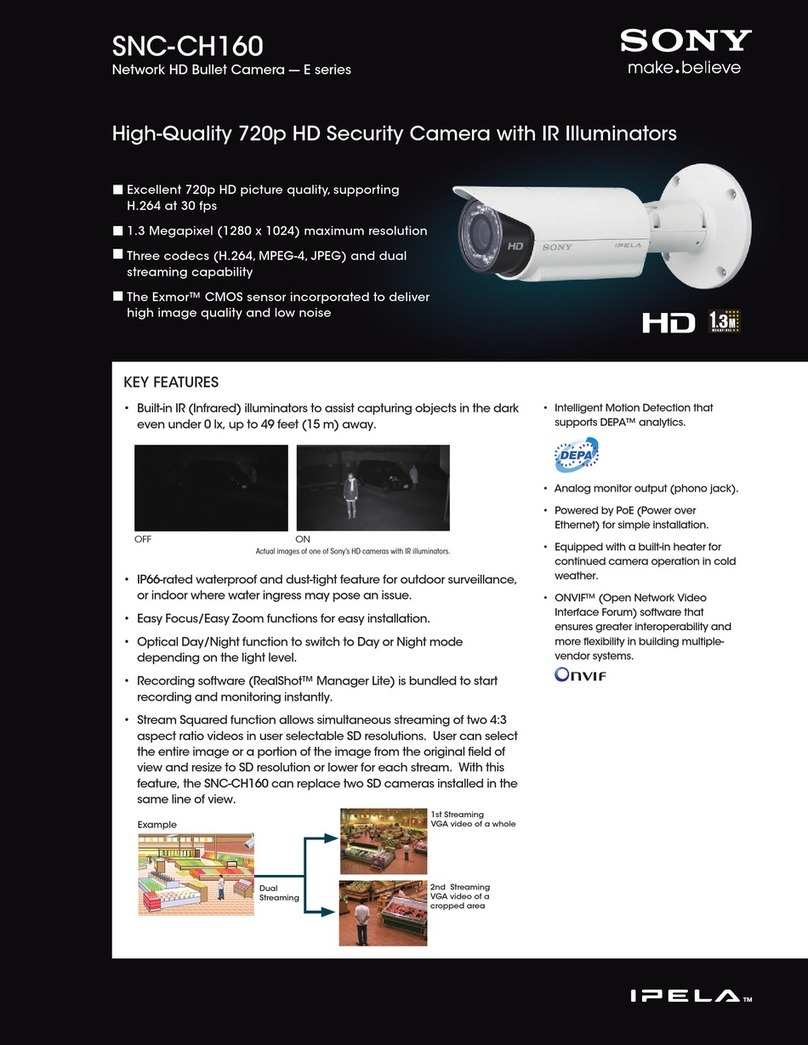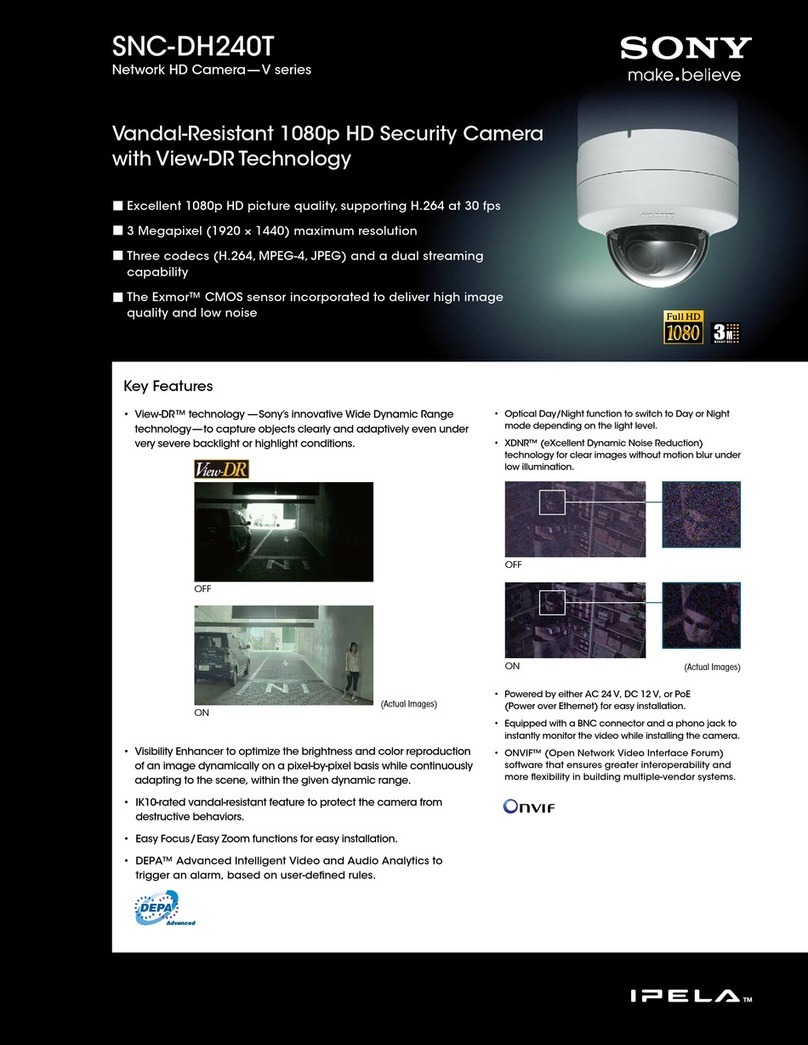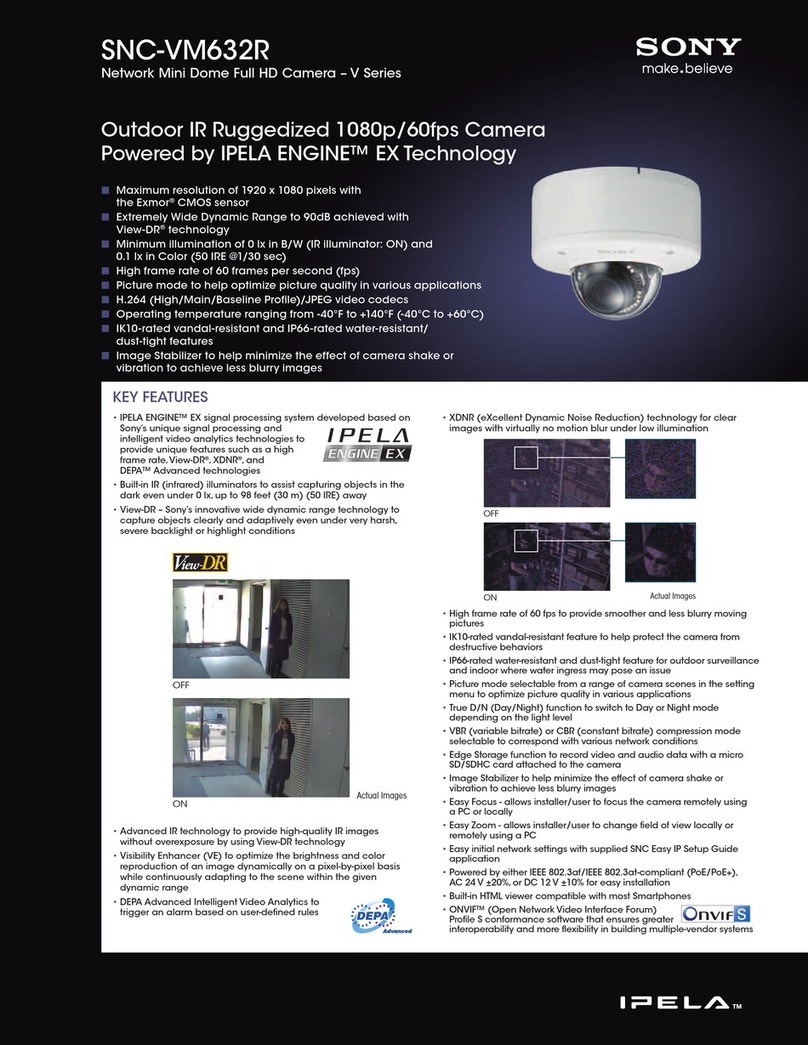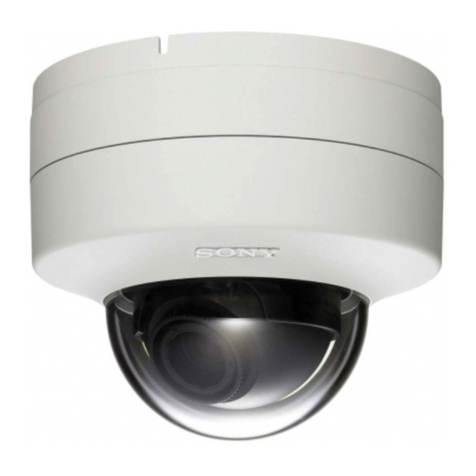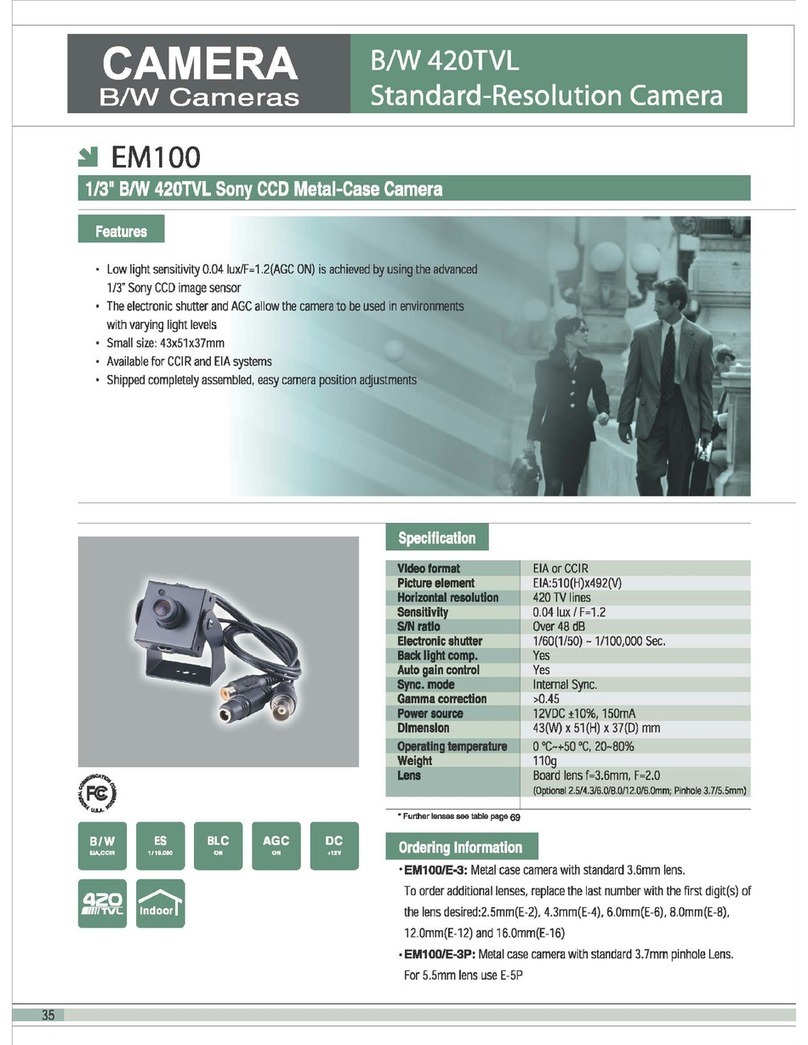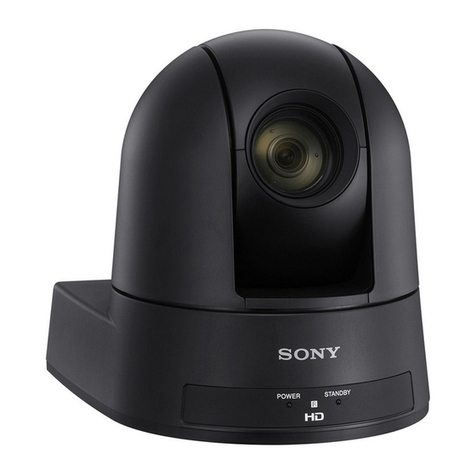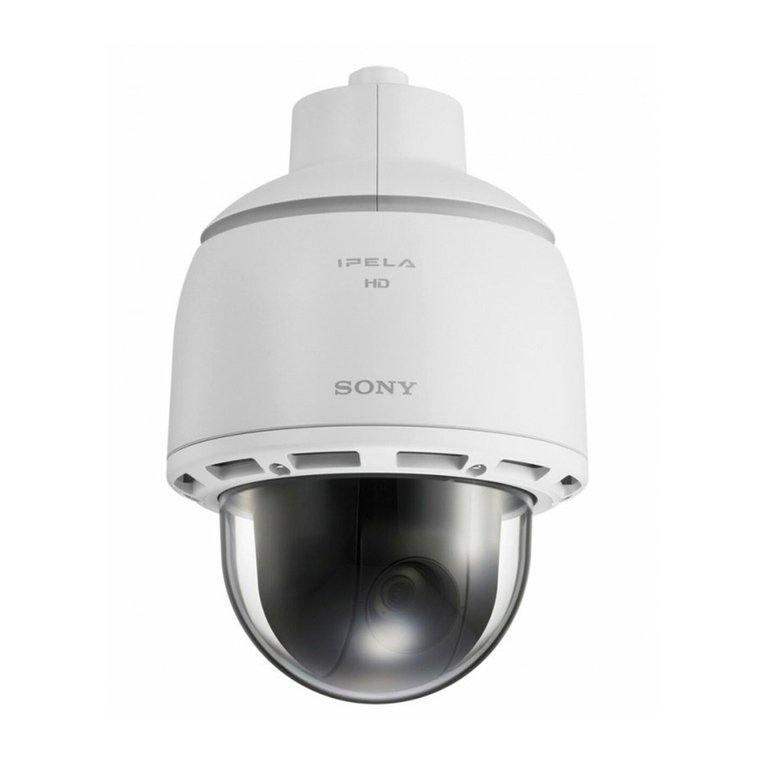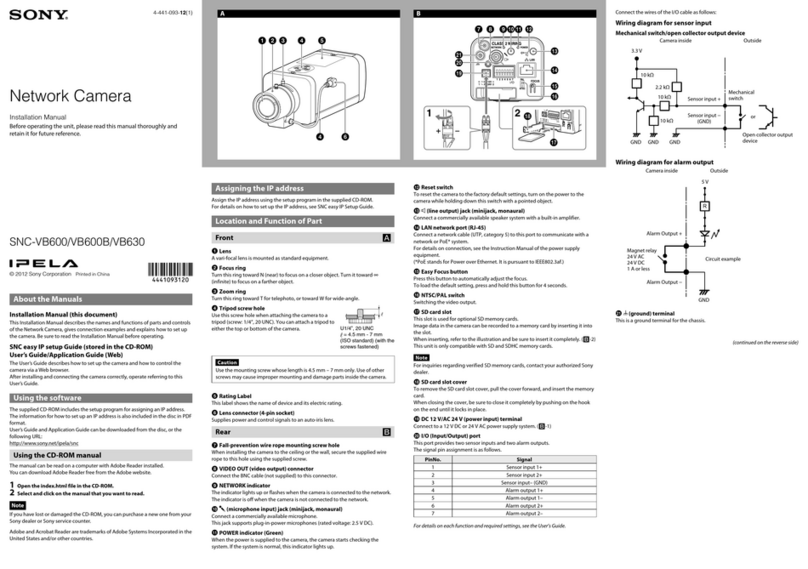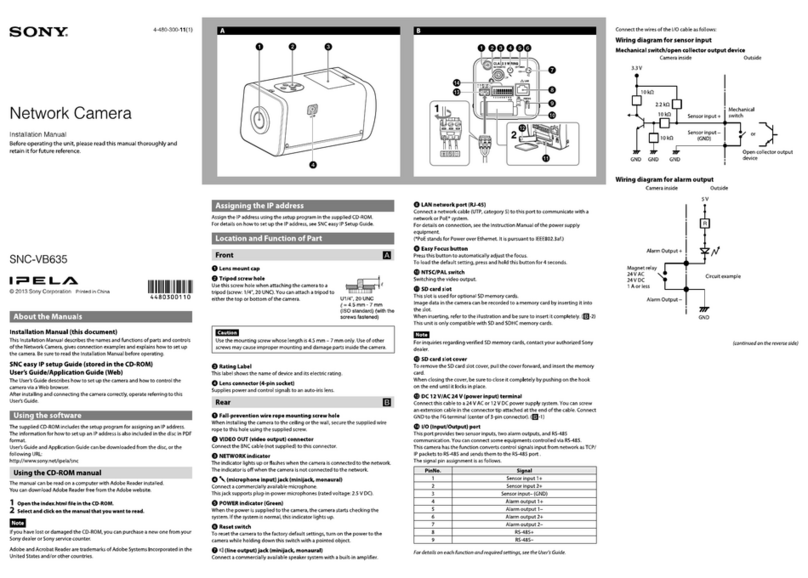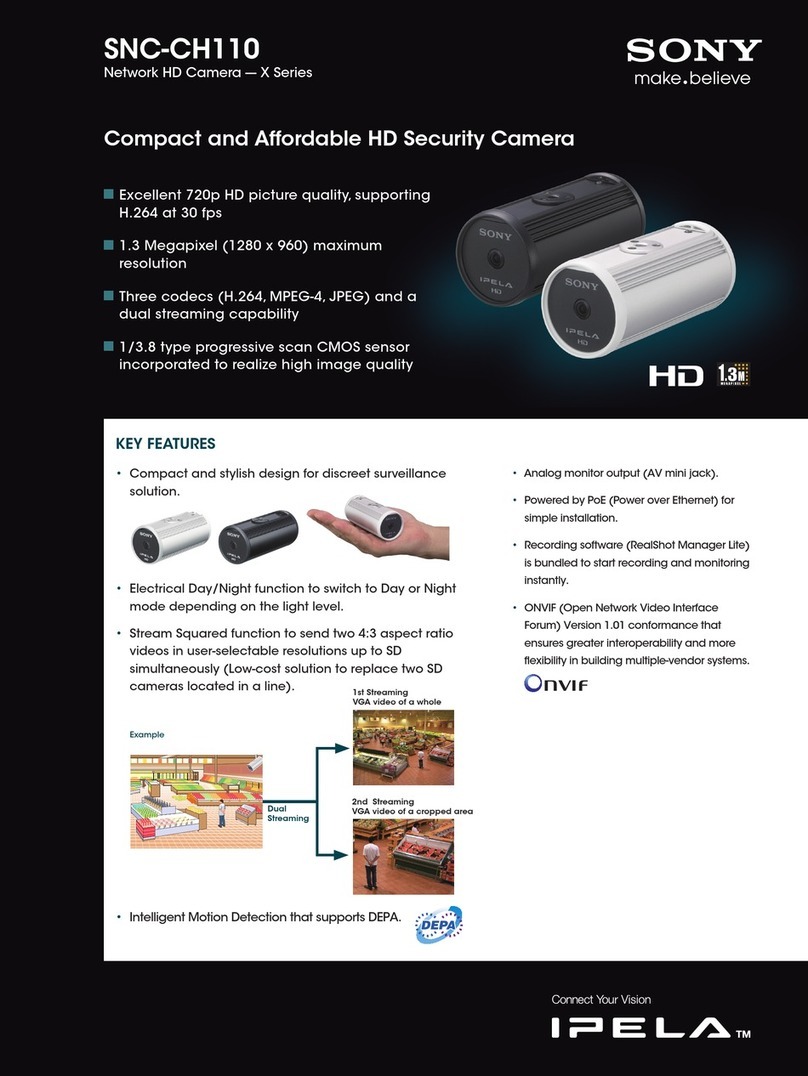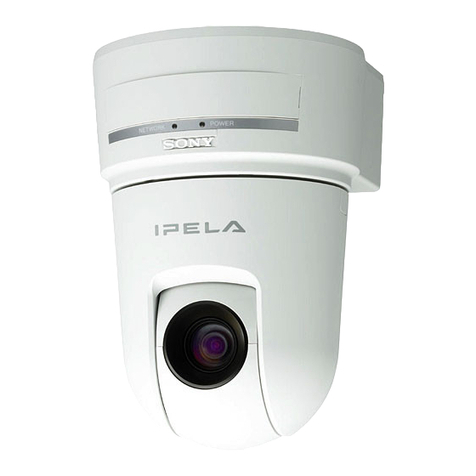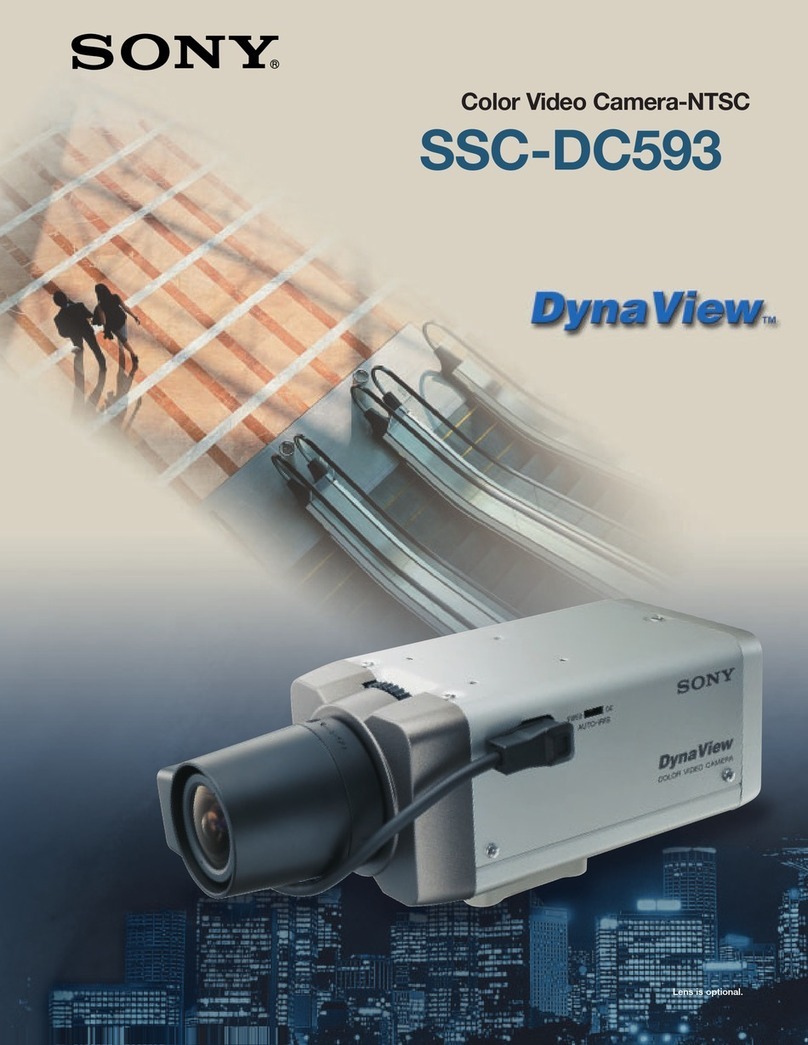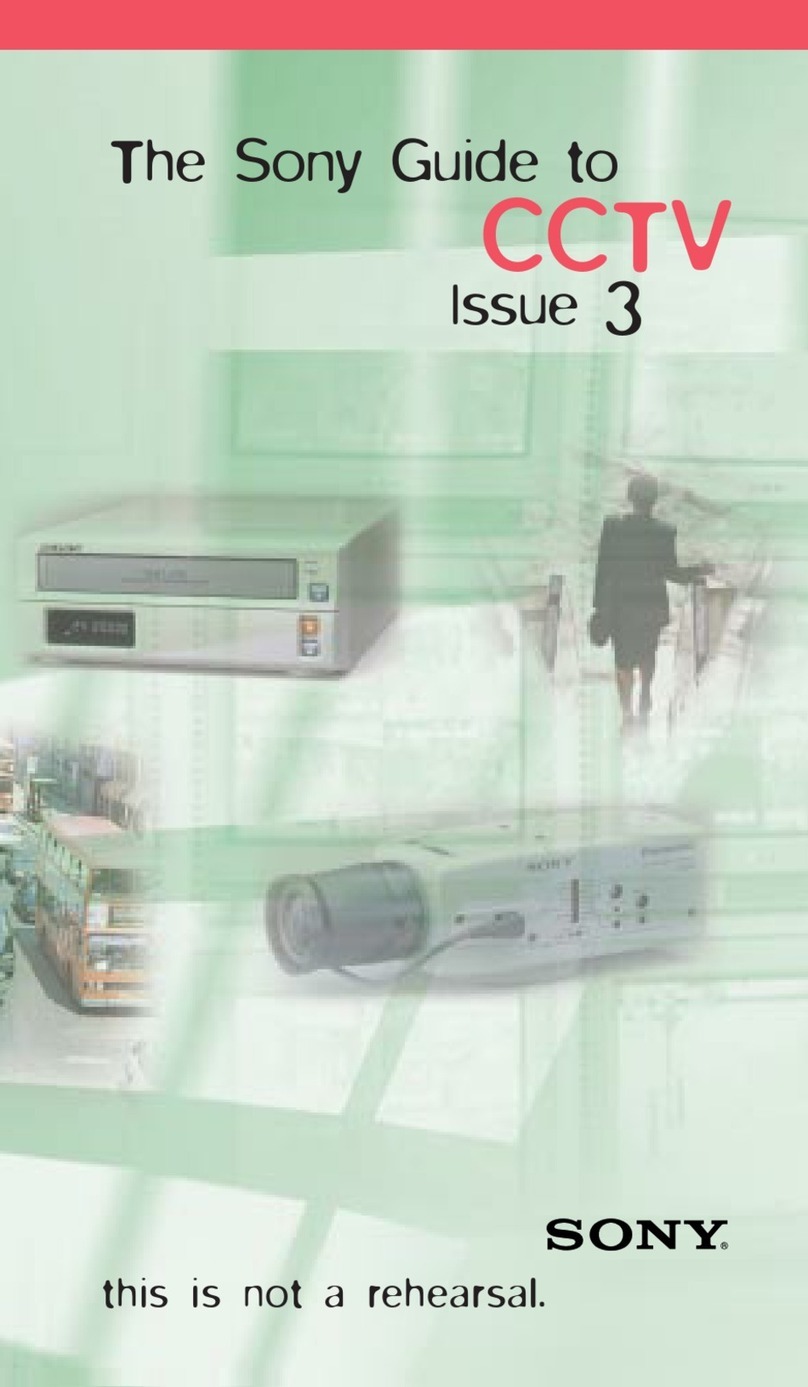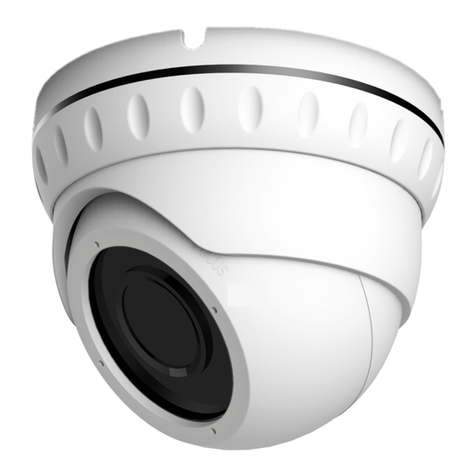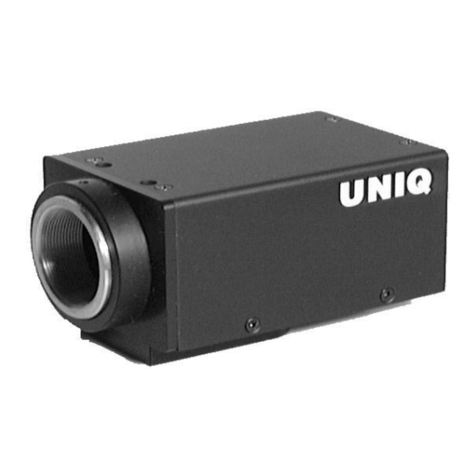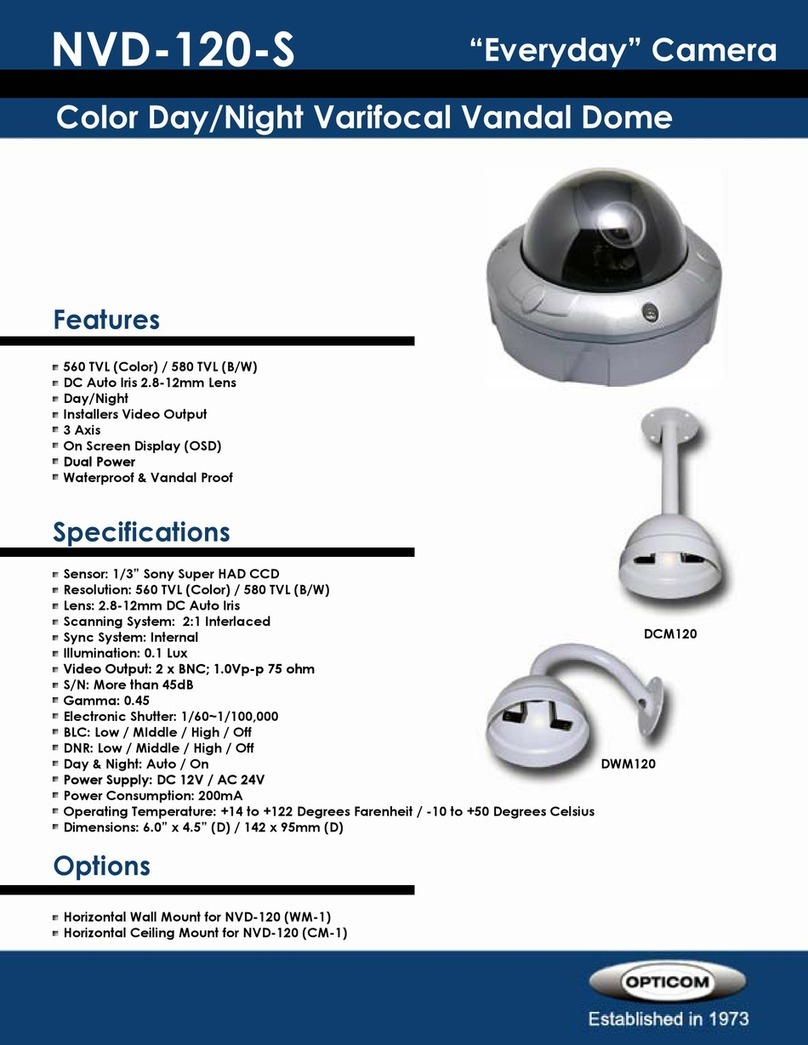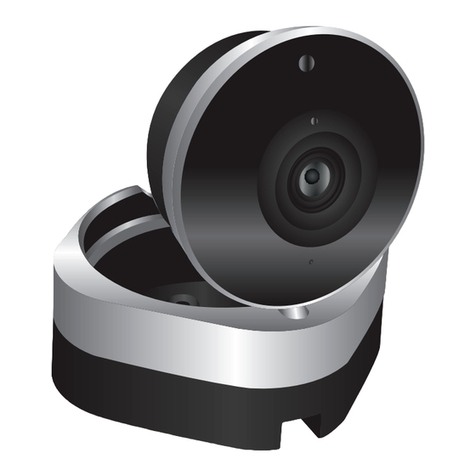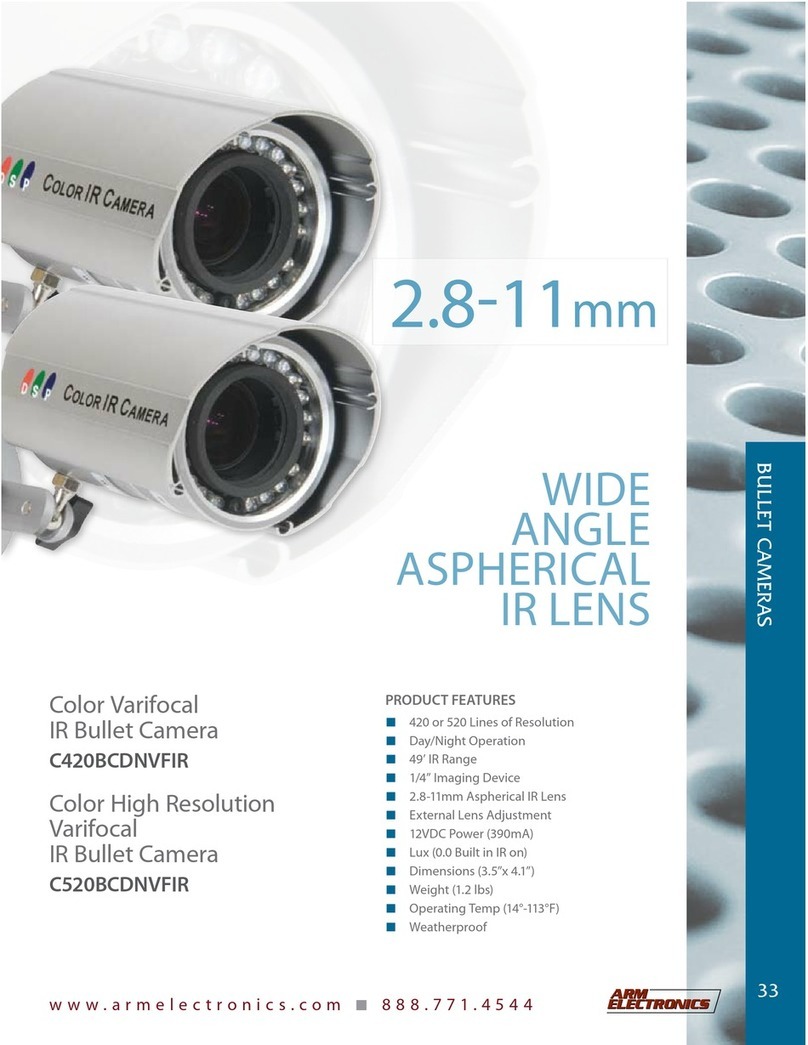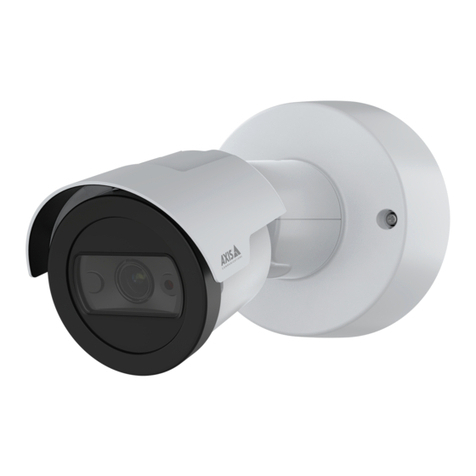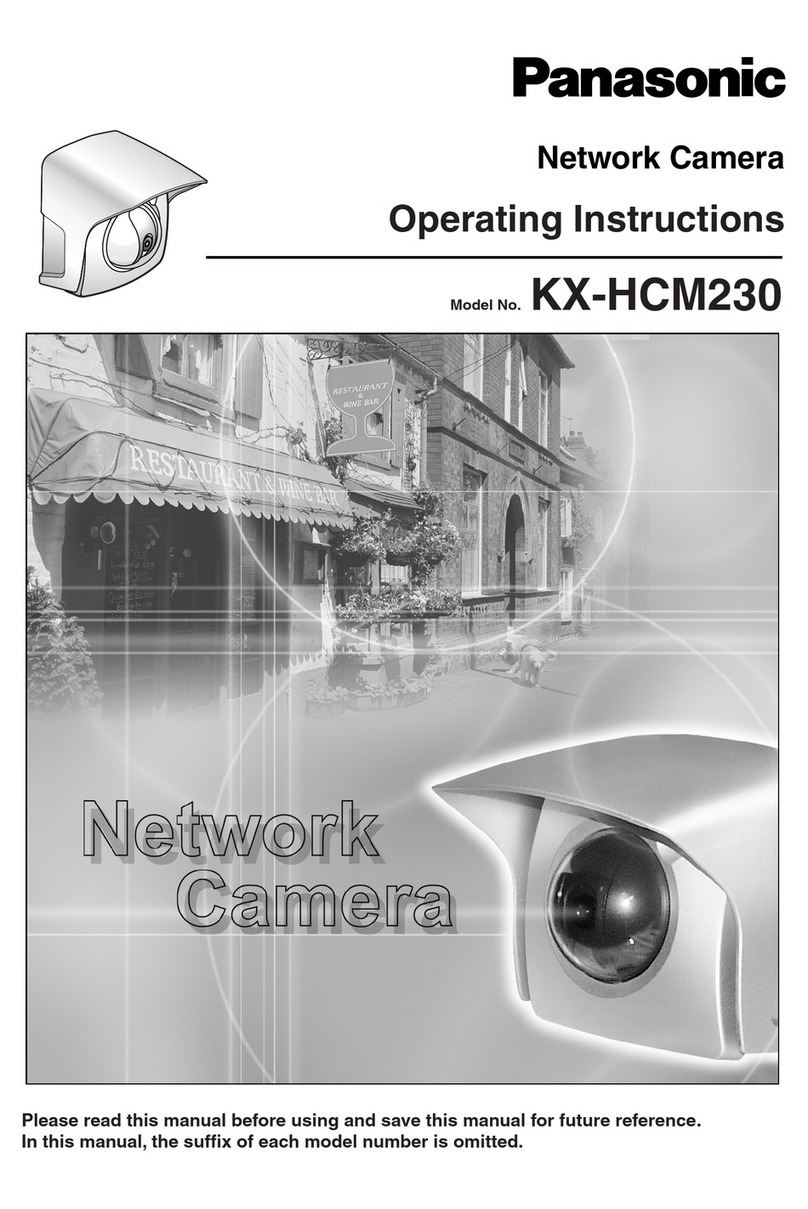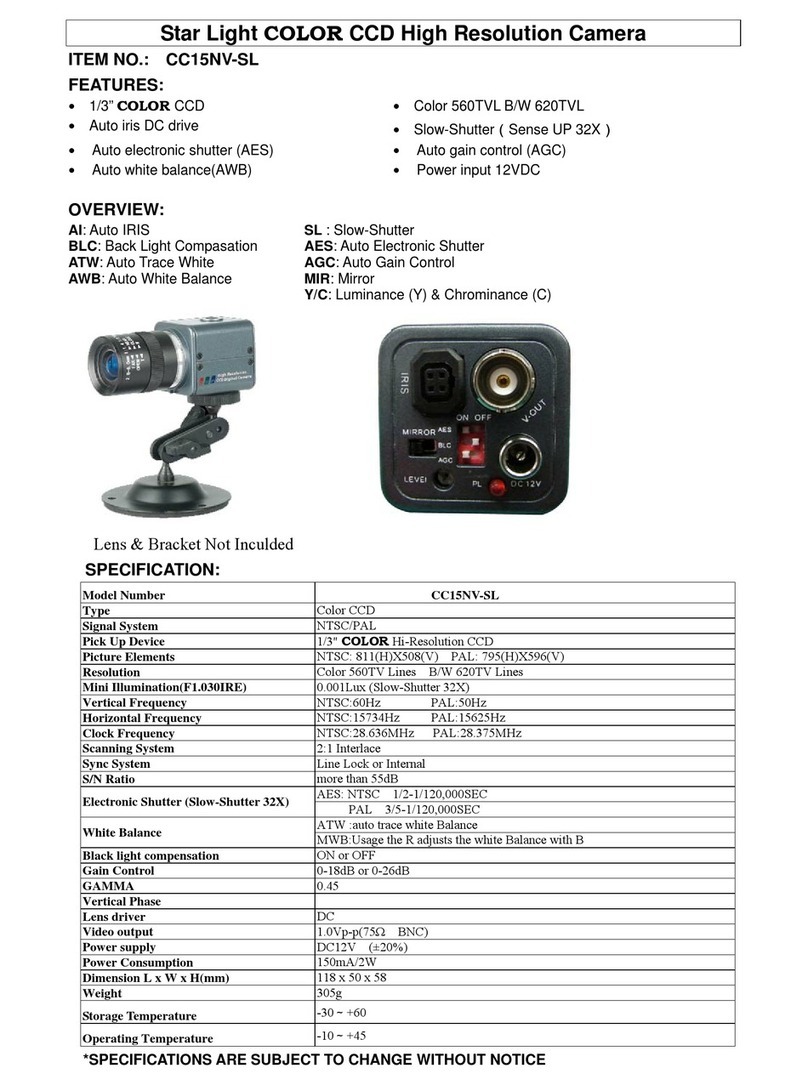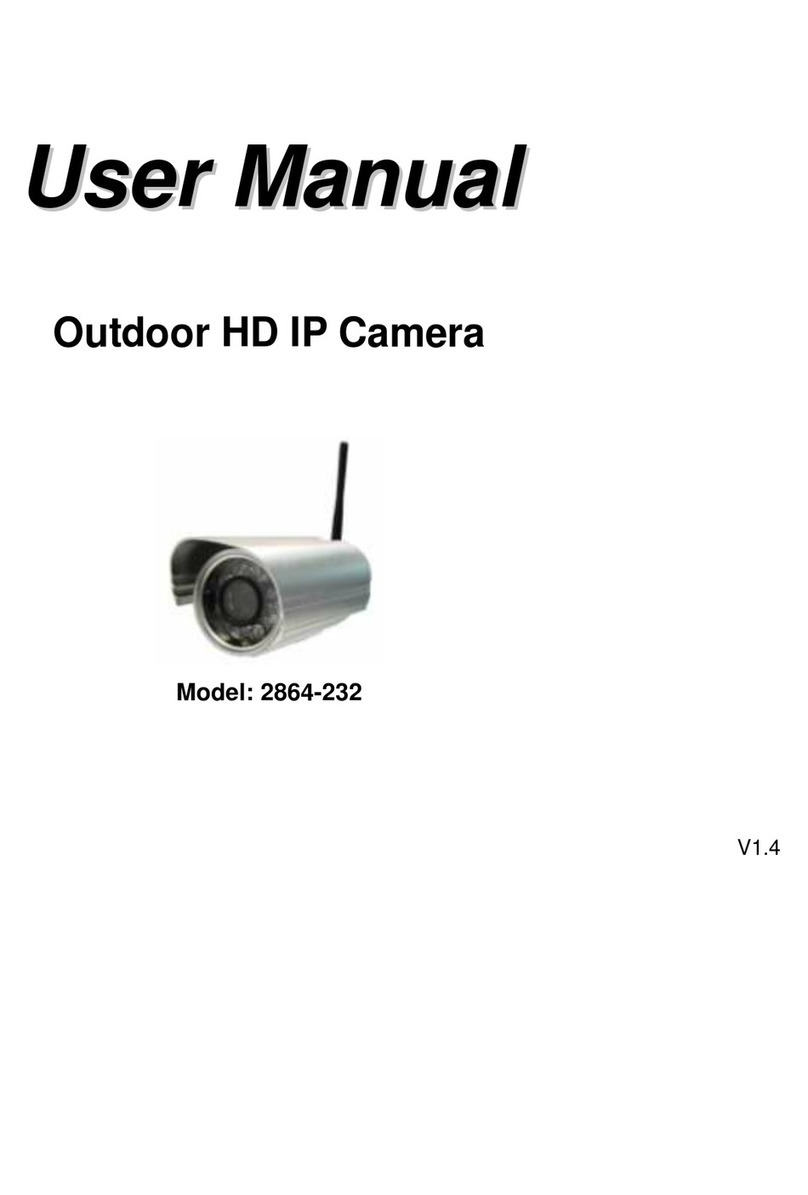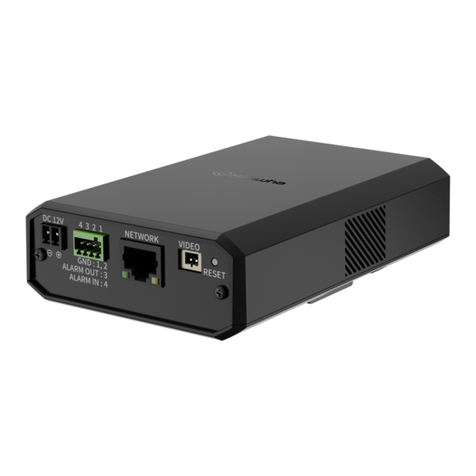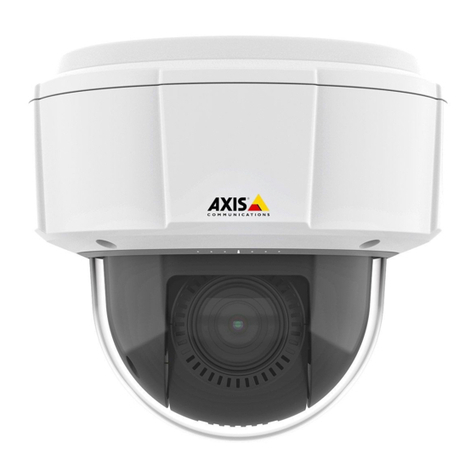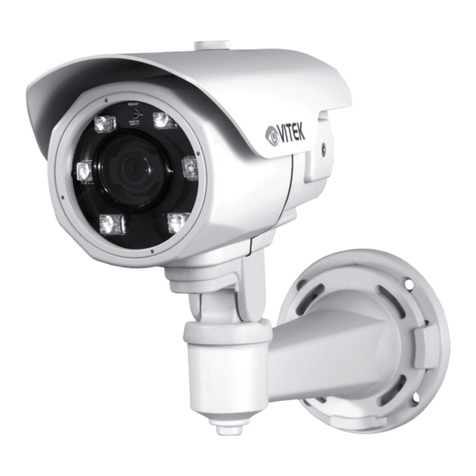
A
B
C
Alignment sticker for the camera base
Ø141.2 (5 /)
Ø129 (5 /)
124°
Hole for
the I/O
cable
116°
6°
6.74 (/)
Ø20
(/) 12 (/) 12 (/)
56.95 (2 /) 54.7 (2 /)
Ø14 (/)
30.28
(1 /)
50 (2)
34.18
(1 /)
64.15 (2 /)
3 x Screw hole
Hole for the
network
cable
Alignment sticker for the mounting plate
6.29 (/)
55.73 (2 /)
48.7 (1 /)
49.35 (2)
55 (2 /)
59.87 (2 /)
24.81
(1)
35.85 (1 /)
35.38
(1 /)
60.67 (2 /)
24.49
(/)
120°
Ø122
(4 /)
Ø142
(5 /)
A-a. B-b. C-c. pair
for Electric Box
3 x Screw hole
for wallmount
& ceilingmount
6.38 (/)
120°
About the Manuals
Installation Manual (this document)
This Installation Manual describes the names and functions of parts and controls
of the Network Camera, gives connection examples and explains how to set up
the camera. Be sure to read the Installation Manual before operating.
SNC easy IP setup Guide (stored in the CD-ROM)
User’s Guide/Application Guide (Web)
The User’s Guide describes how to set up the camera and how to control the
camera via a Web browser.
After installing and connecting the camera correctly, operate referring to the
User’s Guide.
Using the software
The supplied CD-ROM includes the setup program for assigning an IP address.
The information for how to set up an IP address is also included in the disc in PDF
format.
User’s Guide and Application Guide can be downloaded from the disc, or the
following URL:
http://www.sony.net/ipela/snc
Using the CD-ROM manual
The manual can be read on a computer with Adobe Reader installed.
You can download Adobe Reader free from the Adobe website.
1Open the index.html file in the CD-ROM.
2Select and click on the manual that you want to read.
Note
If you have lost or damaged the CD-ROM, you can purchase a new one from your
Sony dealer or Sony service counter.
Adobe and Acrobat Reader are trademarks of Adobe Systems Incorporated in the
United States and/or other countries.
Assigning the IP address
Assign the IP address using the setup program in the supplied CD-ROM.
For details on how to set up the IP address, see SNC easy IP Setup Guide.
Location and Function of Part
Side
Cables are not connected when the unit comes from the factory.
I/O connectors
Equipped to a sensor input and alarm output.
Each connector is adapted to the following signal.
+ 3V3: For maintenance use only.
DO: Alarm output
DI: Sensor input
GND: Ground
For details on each function and required settings, see the User’s Guide.
For the wiring, see “Connecting the I/O connectors.”
Power input (Black)
Connect to a 12 V DC power supply system.
Caution
To connect a 12 V DC power supply system, use the following DC plug.
DC plug: PL03B: Straight, center positive,
outer diameter 5.5 mm, inner diameter 2.1 mm
, I/O (input/output) cable
Audio
Used for the line output connector (green) and the microphone input connector
(pink).
Microphone input connector (minijack, monaural)
Connect a commercially available microphone.
Line output connector (minijack, monaural)
Connect a commercially available speaker system with a built-in amplifier.
Caution
Take care not to trap the cables between the camera and the ceiling or the wall. If
the cable is trapped, it may cause a fire or electric shock due to breaking.
Inside
Built-in microphone contact
Align to the spring contact when attaching the dome case.
microSD card slot
This slot is used for optional microSD memory cards.
Image data in the camera can be recorded to a memory card by inserting it into
the slot.
When inserting, point the contact area at the camera base side, and be sure to
insert it completely.
This unit is only compatible with microSD and microSDHC memory cards.
Note
For inquiries regarding verified microSD memory cards, contact your authorized
Sony dealer.
Dome case
Spring contact
Align to the built-in microphone contact when attaching the dome case.
Lens
Camera base
Strap hole
LAN network port (RJ45)
Connect a network cable (UTP, category 5) to this port to communicate with a
network or PoE* system.
For details on connection, see the Instruction Manual of the power supply
equipment.
(*PoE stands for Power over Ethernet. It is pursuant to IEEE802.3af.)
Connector (J7)
Connect the I/O cable.
Connector (J8)
Connect the I/O cable.
When you do not use the mounting plate
When you use the mounting plate
D
1
2
Stopper for the hole of the I/O cable
Rubber stopper for the hole
of the network cable
Preparation for the network cable
1
Rubber seal plug
2
12 mm (/ inch)
3
4
When connecting or removing the
LAN cable be careful not to damage
the surrounding components.
Note
4-529-630-12(1)
© 2013 Sony Corporation Printed in China
Network Camera
SNC-HM662
Installation Manual
Before operating the unit, please read this manual thoroughly and
retain it for future reference.
Reset switch
When you press and release the reset switch, the camera restarts. When you
press and hold the reset switch, the camera is reset to the factory default
settings.
POWER indicator
When the power is supplied to the camera, this indicator lights up.
NETWORK indicator
The indicator lights up or flashes when the camera is connected to the network.
The indicator is off when the camera is not connected to the network.
Installation
WARNING
If you attach the camera in the height such as the wall or the ceiling, etc.,
entrust the installation to an experienced contractor or installer.
If you install the camera on the ceiling, ensure that the ceiling is strong
enough to withstand the weight of the camera plus the mounting plate and
then install the camera securely. If the ceiling is not strong enough, the camera
may fall and cause serious injury.
If you install the camera in a high place or ceiling, attach the optional rope to
prevent the camera from falling.
If you attach the camera to the ceiling, check periodically, at least once a year,
to ensure that the connection has not loosened. If conditions warrant, make
this periodic check more frequently.
Deciding the Installation Location of the Camera
When you do not use the mounting plate
(When connecting cables from the bottom of the camera)
After deciding the direction in which the camera will shoot, make a hole (ø 14
mm (/ inches)) for the network cable and a hole (ø 20 mm (/ inches)) for the
I/O cable using the supplied Alignment sticker for the camera base, thread the
network cable and I/O cable, then decide the hole positions (three) for attaching
the camera base.
When you use the mounting plate
(When connecting cables from the side of the camera)
After deciding the direction in which the camera will shoot, decide the hole
positions (three) for attaching the mounting plate using the supplied Alignment
sticker for the mounting plate. Then thread the network cable and I/O cable
through the side of the mounting plate, and secure the mounting plate on the
ceiling/wall with three screws. Refer to“Mounting screws” for the screws to be
used.
Mounting screws
The required mounting screws differ depending on the installation location and
its material. (Mounting screws are not supplied.)
Steel wall or ceiling: Use M3 bolts and nuts. (Hexagon head bolt should not be
used.)
Wooden wall or ceiling: Use M3 tapping screws. The panel thickness must be
15 mm (/ inch) or more.
Concrete wall: Use anchors, bolts and plugs suitable for concrete walls. (Head
shape of M3 bolt: Pan head screw or hexagon head bolt should not be used.)
Junction box: Use screws to match the holes on the junction box. (Head shape
of screw: ø 7 mm (/ inch) Height 3 mm (/ inch) or less. (When you do not use
the mounting plate))
WARNING
The required mounting screws differ depending on the installation location and
its material. If you do not secure the camera with the appropriate mounting
screws, the camera may fall off.
Preparation for the Network Cable and I/O Cable
Prepare the cables as required for your usage.
1Remove the dome case from the camera base by loosening the four
screws with the supplied screwdriver.
2Remove the rubber stopper for the hole of the network cable.
Remove the stopper for the hole of the I/O cable by using a flat tip
screwdriver.
Preparation for the network cable
Size of the network cable (unit: mm)
Recommended cable diameter: 24 AWG (0.51 mm (/ inches))
Note
Use the cable of 5 mm to 8 mm (/ inches to / inches) diameter for the
network cable. If you use another thickness of cable, waterproof performance
may be impaired.
Assembly procedure
1Make a hole through the rubber seal plug, then thread the network
cable.
2Peel a part of the sheath of the network cable.
3Attach the connector to the network cable.
Note
For attaching the connector to the network cable, you need a crimper (RJ45).
4Thread the cable through the bottom of the camera base, connect the
network cable to the LAN port (RJ45), then attach the rubber seal plug to
the camera base for waterproofing.
Note
When connecting or removing the LAN cable be careful not to damage the
surrounding components.
Preparation for the I/O cable
1Attach the supplied rubber washer to the I/O cable.
2Thread the I/O cable through the bottom of the camera base, then secure
the plastic base part.
3Connect the I/O cable to the connector (J8) and connector (J7).
Notes
Secure with 0.5 N-m.
Do not pull on any cables forcefully, as a connection may become loose.
(continued on the reverse side)
Preparation for the I/O cable
1
Plastic base part
Rubber washer
2, 3
Connector (J8) Connector (J7)





